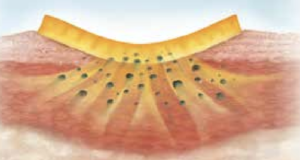What is Manuka Honey?
TheraHoney products contain 100% sterile, medical-grade Manuka honey with no fillers or additives. Manuka honey is derived from the pollen and nectar of the Leptospermum scoparium plant in New Zealand. The honey comb is used only one time, and once harvested, the honey is carefully filtered, irradiated and tested in a laboratory for high efficacy.
Manuka honey has unique properties that help create a moist wound environment conducive to wound healing, promote natural (autolytic) debridement to clear away necrotic tissue, and reduce wound odor.

The illustration above demonstrates how the osmotic action of Manuka honey draws exudate from subcutaneous tissue to the wound surface, removing debris, slough and necrotic tissue..
The Role of Sugar in Autolytic Debridement
The high sugar levels (87%) in TheraHoney result in osmotic activity that helps promote natural (autolytic) debridement to clear away necrotic tissue, maintain a moist wound environment conducive to wound healing, and reduce wound odor.
The Impact of Manuka Honey on Wound pH
Chronic, non-healing wounds often have an elevated alkaline environment. Lowering the pH can aid in wound healing, and the use of Manuka honey dressings is associated with a statistically significant decrease in wound pH and a reduction in wound size.1
Reduced Necrotic Tissue and Wound Size
Using TheraHoney Gel, wounds significantly improved in terms of necrotic tissue reduction and wound surface reduction over an average of 4 weeks.2,3

References:
1. Gethin GT, Cowman S, Conroy RM. The impact of Manuka honey dressings on the surface pH of chronic wounds. International Wound Journal. 2008; 5(2):185-194. Available at: http://www.ncbi.nlm.nih.gov/pubmed/18494624. Accessed November 6, 2014.
2. Livingston M. The use of Leptospermum (manuka) honey gel to manage wounds that have significant presence of necrotic tissue. Presented at: The Wound, Ostomy and Continence Society’s 45th Annual Conference; June 2013; Seattle, WA.
3. Wahab N. Promotion of autolytic debridement by maintaining a moist wound healing environment via the use of medical grade honey in a long term acute care setting. Presented at: The Clinical Symposium on Advances in Skin and Wound Care; October 2013; Orlando FL.